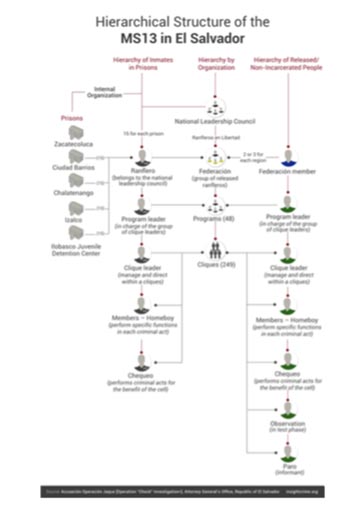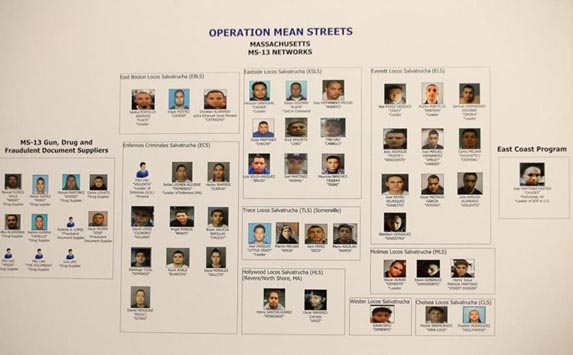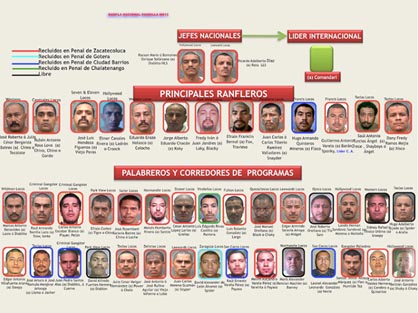Third Generation Gangs Strategic Note No. 13: Mara Salvatrucha (MS-13) Command and Control (C2) Geographic Variations
Robert J. Bunker and John P. Sullivan
Mara Salvatrucha (MS-13) is a well-known and extremely violent street, and in Central America, prison gang with an estimated transnational membership of 50,000 to 70,000 individuals.[1] Essentially a transnational gang network, MS-13 maintains a relatively robust media presence due to its ongoing criminal activities within the United States, many of which have resulted in homicides and even torture killings, as the gang continues to expand into new communities in Texas and the East Coast of the United States. The gang is organized on a networked, i.e. biological (and/or software program) based model with open architecture ‘plug ins’ that utilize a cellular synapse/and open coding-like strategy that facilitates network linkages and alliances, i.e., interfaces with violent non-state actors (VNSAs). Such network interfaces and organizational schemes go by a number of terms including netwar (John Arquilla and David Ronfeldt) and open-source warfare (John Robb).[2] This note specifically looks at the C2 geographic variations of the Mara Salvatrucha (MS-13) network in the United States, Mexico, and Central America (primarily El Salvador) and MS-13s interface with more powerful violent non-state actors (VNSAs) which result in localized hierarchical organizational expressions.
Key Information: Kristina Finale, MS-13 in the United States and Federal Law Enforcement Efforts. Washington, DC, Congressional Research Service, 20 August 2018, https://fas.org/sgp/crs/homesec/R45292.pdf:
Organizational Structure
In the United States, MS-13’s organizational structure largely consists of loosely organized cells, or “cliques.” These cliques vary in size and in the number that may exist in a particular locale, but each clique typically has ties to a particular territory. Researchers have noted that this territory serves two purposes: (1) it contributes to a clique’s sense of neighborhood and community, and serves as a place where they can recruit, and (2) it is an area where the gang generates money from illicit activities such as extortion or charging “rent” on local businesses.
In some areas of the country, MS-13 cliques are more organized, and several operate as part of a larger “program.” In some instances, in “places where the MS13 is very organized, such as Los Angeles and El Salvador,” there may be an additional organizational layer where programs answer to a ruling council. Generally, the U.S. MS-13 structure of relatively diffuse cliques differs from the gang’s more organized structure in El Salvador.
Some have suggested that MS-13 may try to consolidate its power structure to exert more direction over the U.S. cliques; this has been attempted unsuccessfully at various times, and the extent to which such control may take hold has been debated. In some instances, leaders in El Salvador, including prison-based leaders, have tried to exert more direction over activities of U.S. programs and cliques; however, researchers have indicated that leadership in El Salvador may have little or no direction over activities of the powerful MS-13 programs and cliques in the United States. [Citations removed, see original text for citations]
Key Information: MS13 in the Americas. Washington, DC: InSight Crime and Center for Latin American and Latino Studies, February 2018, https://www.insightcrime.org/wp-content/uploads/2018/02/MS13-in-the-Americas-InSight-Crime-English.pdf:
Organizational Structure
The MS13 is complex on certain levels and simple on others. It is, as a recent indictment in El Salvador described it, “collegial, multi-layered and multi-membered.” (Operación Jaque, 2016) But the gang operates without any clear hierarchy or any single boss controlling it. Instead, there are layers of leadership structures whose purview and control over their members is as dynamic as the gang itself.
In the top layer, there are leadership councils formed by seasoned veterans. Below that are what are called programs, which are managed by mid-level leaders. These programs manage the cells of the gang, or cliques. These cliques are semi-autonomous and exert the most influence over their members.
To a certain extent, this system has worked to help spread the gang’s brand and in influence. Cliques are subtly encouraged to beef up their ranks, expand their criminal activity and establish themselves in new areas. But this system has its drawbacks. Most notably, its diffuse nature has undermined the gang’s ability to mature into a more sophisticated criminal operation that can function as a single organization over a wide geographic expanse…
Programs and Ruling Councils
In the early 2000s, the MS13 began a process of internal reorganization inside El Salvador. This reorganization was driven by two relatively new realities: 1) most of the gang’s leadership was incarcerated; and 2) the gang had grown into a huge organization. The result was chaos on the streets, lack of control inside the prisons, and vulnerability in both places.
To combat these trends, the gang instituted internal rules and created a more hierarchical organizational structure in each of the areas where it was operating. To begin with, they created group of cliques that they called “programs.”
These cliques operate under the aegis and control of a program coordinator, which in most places is referred to as a “corredor,” or a “runner.” These leaders are chosen based on longevity, history, commitment, pedigree and personality. The ones that run the programs are responsible for being the interlocutors between the cliques and the ruling councils or shot-callers. They also have to resolve issues between and often among cliques. They can determine such things as territorial demarcations of cliques or the fate of individual gang members if they have committed major transgressions.
Like cliques, programs are nominally tied to territories. The East Coast Program is tied to the East Coast of the United States, the Los Angeles Program to the West Coast. But programs can also be international, which normally represent the most powerful cliques that have spread throughout the region because of migration like the aforementioned Normandie Locos.
In other words, powerful cliques can themselves become programs, grouping other cliques beneath them. Clique leaders can therefore be the heads of their clique and the corredor of a program at the same time. However, gang members report that fealty to the program is not the same as fealty to the clique. The clique is always above the program, they assert. The program is merely an organizational tool that carries little symbolic weight to the individual gang member. It is mostly a means by which the gang’s highest leaders can channel communications, organize its criminal economy, and impart orders regarding strategy and direction…
Source: Acousación Jaque (Operación Jaque, 2016), Fiscal General de El Salvador as rendered by InSight Crime.
Key Information: Milton J. Valencia and Maria Sacchetti, “Raids target violent MS-13 gang.” Boston Globe, 29 January 2016, https://www.bostonglobe.com/metro/2016/01/29/local-and-federal-law-enforcement-target-violent-gang-early-morning-raids/wOnCmfWqDBYvKvcxpfeS6I/story.html:
Law enforcement officials on Friday charged 56 people with running a vast criminal enterprise with the motto “kill, rape, and control’’ that allegedly sold drugs and carried out five murders in immigrant communities throughout Greater Boston.
Authorities conducted raids in Boston and north of the city before dawn Friday, and said afterward that they had dismantled much of the East Coast chapter of a violent, international street gang called MS-13 that recruited vulnerable teenagers at area high schools and instilled fear among their peers.
“This is an organized gang engaging in murder and attempted murders, using machetes, knives, and chains,” US Attorney Carmen M. Ortiz said at a news conference Friday, where several knives and guns confiscated in the three-year operation were laid out on a table….
JONATHAN WIGGS/GLOBE STAFF
“A chart of photographs at the Moakley Federal Court House showed those individuals targeted in the raids.” Source: Exhibit from Operation Mean Streets (2016) as reported by the Boston Globe.
The law enforcement operation, named Mean Streets, included more than 400 officers from the FBI, US Department of Homeland Security, State Police, and Boston and Chelsea police in the Friday raids.
Teams of federal agents and local police piled into SUVs, minivans, and unmarked sedans and fanned into darkened neighborhoods. In Chelsea, officers wearing bulletproof vests and carrying flashlights banged on windows and doors at two buildings near the police station. In East Boston, a SWAT vehicle idled discreetly behind a shopping area as the raids unfolded…
Key Information: Hector Silva Avalos, “The Ties Between the MS13 in the US and El Salvador.” InSight Crime, 13 July 2015, https://www.insightcrime.org/news/analysis/the-ties-between-the-ms13-in-the-us-and-el-salvador/:
Moises Humberto Rivera-Luna, alias “El Viejo Santos,” is one of six Mara Salvatrucha leaders the US Treasury Department blacklisted in June 2013. Three years and three months earlier, on March 9, 2010, an FBI patrol raided a house in a Latino neighborhood in Maryland. There, they found the first evidence of a new relationship between MS13 cliques along the US East Coast and its imprisoned leadership in El Salvador.
This evidence consisted of two receipts for money transfers made via Western Union by Edgar Granados, a member of the Normandie Locos Salvatruchos clique. The money was received in El Salvador by a woman named Julia Perez Abarca, who, at that time, was regularly visiting Viejo Santos in the Chalatenango prison. Following the raid, an investigation revealed that ties between El Salvador’s imprisoned “big bosses” and the “shot-callers” (palabreros) along the US East Coast had been revitalized.
Involved in this restoration of ties were certain gang members who played a role in the gang truce with the government of ex-President Mauricio Funes. Revista Factum has reconstructed this chapter of the MS13’s history in Maryland via an exhaustive review of judicial documents and hours of interviews with police, defense lawyers, and ex-gang members in San Salvador…
An El Salvador police intelligence document showing the structure of the MS13.
Source: InSight Crime, 13 July 2015.
The beginning of 2010, when Jose Martinez Amaya and Manuel Saravia were named “palabreros,” was a hectic period. Viejo Santos had been exerting strict control over the Normandie clique from El Salvador, insisting on compliance with certain rules. It was also around this time that the Normandie clique received orders from El Salvador to expand their operations in the United States…
Key Information: John P. Sullivan and Samuel Logan, “MS-13 Leadership: Networks of Influence.” The Counter Terrorist, August/September 2010, pp. 48, 50, 52, https://issuu.com/sbradman/docs/ctaugsep2010.final:
Networked Leadership: Mata, Controla, Viola
MS-13’s network configuration frustrates many law enforcement officers looking for a hierarchical organization that they can penetrate. The lack of an overt, formalized hierarchy, manifested through decentralization and the apparent absence of a clear hierarchy or structure, is often interpreted as a lack of sophistication, or a lack of capacity. That is not the case. There is indeed a hierarchy, but it is a “hierarchy of influence” where “respect” and loyalties are expressed through a networked structure.
In operational terms, the “hierarchy of respect” is expressed through a web of social relationships within individual cliques and social/business relationships between cliques. At the clique level, leadership is distributed. There are two primary leaders, the “first word” (primera palabra) and the “second word” (segunda palabra) who operate something like a commander and an executive officer in military settings. The segunda palabra from large, powerful cliques often exerts influence over smaller or subordinate cliques. In many facets, this leadership is neo-feudal, where leadership is determined by fealty to a leader who collects taxes and the support of warriors and in turn offers protection. Order and control are exercised through a variety of communications (including meetings and the targeted use of violence as an enforcement measure). Meetings include clique meetings, known as misas, and generales (or inter-clique coordination meetings).
In addition to the two leaders, other key members include a treasurer, who collects the taxes (the gang’s cut of a range of criminal enterprises and activities), and a single, powerful LA MS-13 leader, who serves as a liaison to the Mexican Mafia (Eme). The Eme representative is a vassal or an Eme “soldier” who ensures MS-13 pays its taxes to Eme, disciplines MS-13 members and associates, organizes and conducts meetings (generales) among MS-13 cliques and shot callers, resolves disputes, and coordinates relations throughout the distributed network, including brokering business transactions and ensuring “respect” is paid to nodes in LA and El Salvador.
Within its own sphere of influence and area of operations, each clique is free to innovate and run local operations (as long as “respect” is given and taxes paid). Enforcement is often brutal, and is simply expressed in the gang’s informal motto, “Mata, Controla, Viola”—kill, control, and rape.
The operational tool is the “green light” or “luz verde”: the authorization to kill those who do not comply. MS-13 gained enhanced sophistication by giving its allegiance in Southern California (Sur) to the Mexican Mafia. La Eme in turn collects a tax and provides protection to MS-13 members incarcerated in county jails, and state or federal prisons in California. Failure to pay the tax results in a green light allowing any affiliated gang to kill violators in jail, prison, or on the street. This brutal enforcement mechanism allows the gang to ensure adherence to its “management vision” throughout the network.
Third Generation Gang Analysis
The basic Mara Salvatrucha (MS-13) organizational structure is based on cliques (clicas; i.e., nodal clusters) with over 400 of these network clusters now existing. Cliques typically range in size from 10 to 100 individuals with geographic variations evident. These self-replicating gang nodes have spread since the late 1970s/early 1980s from the Pico-Union neighborhoods of Los Angeles into Central America (primarily in El Salvador, Honduras, and Guatemala), and then to the US East Coast, initially within the Northern Virginia/DC metropolitan area (National Capital Region). Later they spread throughout most of the rest of the United States (with larger clusters evident in Texas, North Carolina, and the Long Island & Boston regions) as well as into Mexico, Spain, and Italy and other foreign enclaves. MS-13 cliques, in turn, adapt to their host environments by exhibiting different command and control (C2) geographic variations.
These C2 geographic variations are based on the interplay of the individual MS-13 clique (numbers and strength) with more powerful criminal entities (or exploiting criminal power vacuums) within their area of operations (AO). Such geographic variations result in differing MS-13 clique organizational C2 structures manifesting themselves at the operational level—many of which are hierarchical in nature—while at the same time unifying the greater MS-13 ‘networks of influence’ that exist. The MS-13 organization can be viewed through three distinct and interactive lenses (or levels of activity): strategic, operational, and tactical, where strategic level encompasses the network as a whole and the relationships between the various geographic nodes.[3] The operational level encompasses the geographic hubs of activity in Los Angeles, El Salvador, the East Coast, and elsewhere. The operational hubs are comprised of individual clicas (cliques) and programs. The tactical level involves activity by and among the individual cliques.
MS-13 Networks of Influence C2 (Strategic): The more encompassing MS-13 ‘networks of influence’ strategic component can be viewed in Figure 1. Here MS-13 network’s three primary clusters or hubs of activity are described. This currently consists of three hubs: the original Los Angeles-bases Southern California Hub, the El Salvador-based hub extending its influence into the Northern triangle, and an US East Coast-based hub centered on Northern Virginia/Washington, DC Metro Area and extending its influence to Boston, New York (Long Island), North Carolina, and Texas.[4] The Texas node originally served as a way station for Mareros travelling from Los Angeles to the East Coast nodes, but it is evolving into a key node on its own with an emerging hub in Houston.[5] The various MS-13 cliques operating in Mexico are influenced by a range of actors including these in El Salvador, Los Angeles, and increasingly Texas. Tensions among the various nodes create both internal competition, new opportunities, and potentially fragmentation, as evidenced by the recent move to split Mexican cliques from the Salvadoran nodes and forge a new Mexican-bases splinter group: MS-503.[6]
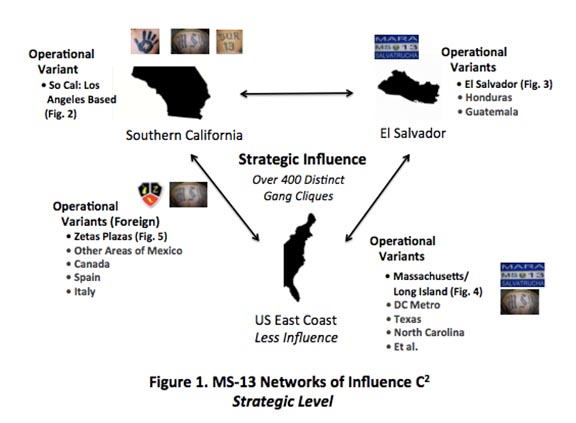
MS-13 Southern California: Los Angeles-Based C2 (Operational): The initial MS-13 clique progenitor—‘Clique 0’ Mara Salvatrucha Stoners (MSS); Mara Stoners—originated in Los Angeles. The initial grouping of cliques that originated from this late 1970s/early 1980s stoner gang have since evolved into a very different type of criminal organization—one that is transnational in scope, increasingly sophisticated as a result of its prison gang and cartel associations, and far more brutal in nature. The Mara Salvatrucha Stoners over time, as the membership demographics changed, dropped the ‘stoners’ moniker and became known simply as Mara Salvatrucha.[7] By the early 1990s, ‘13’ was added to the gang name due to its becoming a vassal Sureños 13 (Sur 13) type gang under the control of the Mexican Mafia (La Eme; eMe, M) even though the gang was mainly composed of El Salvadorans rather than Mexican nationals and Mexican-Americans.[8]
An overview of the Los Angeles (LA or Southern California/SoCal) Hub or ‘Program’ related to this gang’s operational C2 structure can be viewed in Figure 2. The Los Angeles cliques set the template for the gang’s future nodes. The LA cliques are organized with a primera palabra and segunda palabra (first and second word) sharing the clique’s command function and supported by a treasurer and liaison to La Eme. Since MS-13 is integrated into La Eme’s Sureño network, command influence originates from a Mexican Mafia carnal (member; aka Big Homie) in prison through a camarada (La Eme associate) formally and/or facilitator—typically a wife or girlfriend—informally into a crew chief. The crew chief (aka baller or high-roller) may be the camarada, a go between linking the camarada to the MS-13 clique leader, or possibly even the clique leader. Camarada to camarada middle links or associate to camarada middle links may also exist depending on the circumstances of face-to-face prison and kites (hand written messages) access to the carnal. The role of the crew chief—who at the mid-linking level is Sur 13 (but not necessarily a MS-13 member; they could be Florenica, Avenues, et al.)—is to make sure that the MS-13 clique ‘puts in work’ to generate income for the carnal in prison and carry out his dictates.[9] A component of keeping this vassalage system working—money being generated for La Eme, street directives (such as killings) being carried out, and respect given—is the designation of a more senior MS-13 member acting as the street gang’s palabrero (shot caller) liaison with a La Eme carnal (member) also serving in a liaison role.[10] Within this system of vassalage, the more powerful MS-13 palabreros have the potential of being recruited as La Eme associates, or even members, at which point they are no longer considered belonging to the MS-13 street gang but rather have transcended it and now belong to the more powerful and criminally prestigious La Eme prison gang.
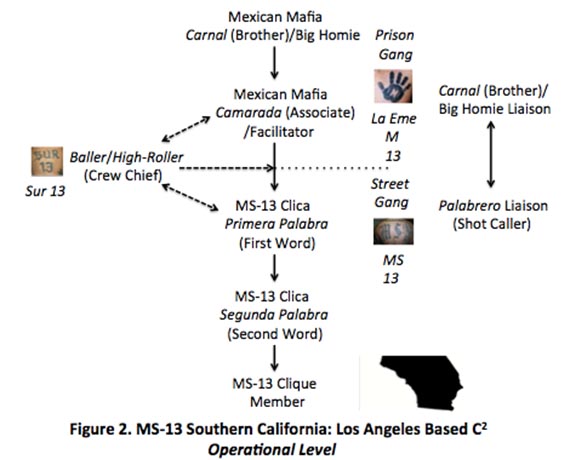
MS-13 El Salvador C2 (Operational): See Figure 3. In El Salvador the MS-13 adapted its organization to meet local conditions and modified its organizational structure to consolidate its extortion and drug markets, accommodate diversification into legal business activities, and ensure protection of its supply chain network, while maintaining order and discipline within the organization. While the El Salvador Operational Level retained dual leadership (the primera palabra and segunda palabra), at the clique level a ‘national’ leadership—the ‘Ranfla’ or a ruling council—emerged. “The main changes in Salvadoran MS-13 structure were the formation of the “Ranfla en Libertad” by trusted ranfleros and the organization of its programs by geographical zone. These modifications were a strategic countermove to the anticipated tough anti-gang measures from the Government of El Salvador.”[11] The collections of cliques known as programas (programs) are the organizing links for MS-13 influence into other geographical regions such as Mexico and the East Coast of the US.
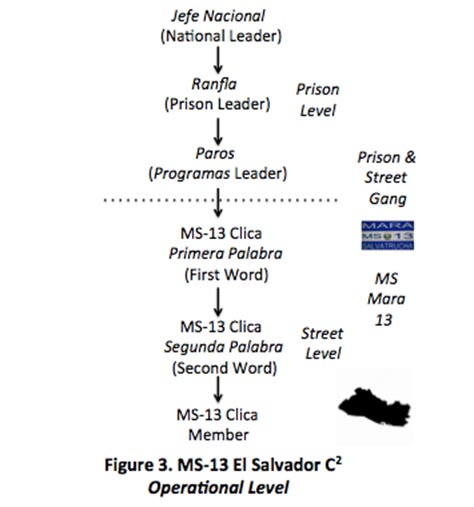
MS-13 Massachusetts/Long Island C2 (Operational): See Figure 4. Massachusetts. MS-13 activities in Massachusetts have strong connectivity to the “Ranfla” in El Salvador. Here, the clica leadership (primera palabra/segunda palabra) exercise tactical leadership while receiving strategic guidance and operational coordination from the program leadership directed from the “Ranfla’ (or “Ranfla General”) in El Salvador. Massachusetts/Greater Boston cliques include “East Boston Loco Salvatrucha, Eastside Loco Salvatrucha, Chelsea Loco Salvatrucha and Everett Loco Salvatrucha” and are grouped into “programs.”[12] The Massachusetts clicas are mostly part of “East Coast Program, run by Jose Adan Martinez Castro, nicknamed “Chucky,’’ who lived in Richmond, Virginia.”[13] A similar relationship is seen in Long Island, NY.[14] Indeed the connectivity to other nodes not only include ‘program leaders at other regional hubs but also inter-connectivity and reciprocal influence with the core ‘hubs’ such as El Salvador. An example is found in the bi-directional Long Island-El Salvador connectivity: “The violent transnational street gang MS-13 has become so ingrained on Long Island that chapters in El Salvador identify themselves by their Nassau and Suffolk counterparts, calling their cliques “Freeport,” “Brentwood,” and “Huntington” among others.”[15] According to Suffolk County (Long Island) police, “The gang’s hierarchy, on a mission to step up the brutality, has sent members from El Salvador to run cliques—or operating units—on Long Island … And because members have traveled back and forth, maintaining contact and giving directives, the name of the various locations on Long Island stuck.”[16]
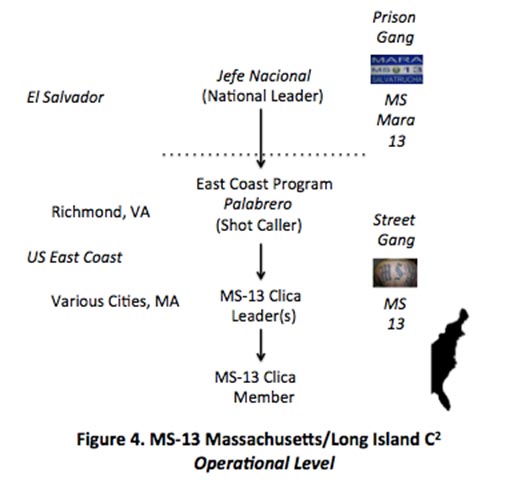
MS-13 Zetas Plazas C2 (Operational): As can be viewed in Figure 5., MS-13 cliques residing in a Zetas plaza (i.e., Zetas controlled city with strategic importance to illicit flows) such as Reynosa or Nuevo Laredo provide us with another geographic expression of operational level C2 of Mara Salvatrucha gang members.[17] This example—which would now be considered a historical one with the demise of the initial Gulf-Zetas alliance and the later fragmentation of both cartels into warring factional elements (Gulf v. Gulf, Gulf v. Zetas, and Zetas v. Zetas)—is derived from the era when the Zetas exerted a military-like command structure in its area of operations (AO). This C2 articulation is derived from the Zeta’s earlier Mexican special forces training (as GAFE; Grupo Aeromóvil de Fuerzas Especiales) which provided them with the capability of creating a sophisticated operational and intelligence composition.[18] The cartel exerted top down operational command via its regional commander into the plaza boss who, in turn, delegated commander’s orders and intent to a lieutenant who then interfaced with a contacted/allied gang such as a MS-13 clique.[19] This represented a very military-style hierarchical structure with the Viejos (Older; original Zs who defected) at the top and the Nuevos (Newer; recruited Zs with military and law enforcement backgrounds) in the mid-command levels initially. At the clique level, its leader would transmit Zetas orders to his rank and file members who then acted as enforcers, sicarios, and general-purpose gunmen as required. MS-13 clique leaders and more capable members had the potential of Zetas recruitment into Lil’ Zetas (20-25 year old trainees) or possibly even Cobras Nuevos (Viejos bodyguards and mobile forces).[20] Such crossover and transcendent membership potentials into that cartel is very much akin to that seen with higher-ranking MS-13 clique leaders (palabreros; shot callers) becoming Mexican mafia (prison gang) associates (camaradas) or members (carnals).
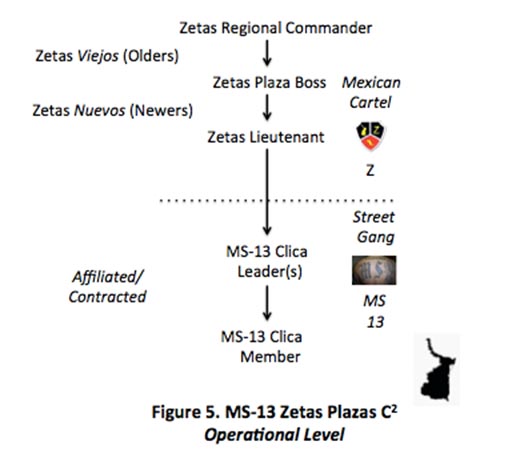
Conclusion
What the four operational level perspectives in Southern California (emanating from Los Angeles), El Salvador, Massachusetts/Long Island, and Zetas plazas (within certain regions of Mexico) have shown is that, within each specific geographic area, the MS-13 cliques adapt their configuration to optimize operations vis-à-vis their host environments. In the case of Southern California, the more dominant and powerful Mexican Mafia (La Eme, la eMe, M) subordinated the MS-13 cliques within their system of Sur 13 street gang vassalage. In El Salvador, a criminal power vacuum existed with regard to that nation’s prison system which MS-13 (as well as their rival 18th Street; Mara 18/Barrio 18) exploited, allowing it vertical power integration on both the street and prison levels thus making it a dominant organized crime entity. Massachusetts and Long Island represent yet another specific case—here, one in which an attempt took place via the MS-13 Salvadoran prison gang leadership to organize the cellular network of MS-13 cliques in that region into a more structured and influential criminal entity, following the Central American program model.
Finally, the Zetas plaza example portrayed how MS-13 cliques contracted/allied to a powerful cartel which de facto controlled various plazas in Mexico. Each example is unique and distinct and reflects the realities of the area of operations (AOR) in which the MS-13 cliques have emerged. Still, it should be remembered that these MS-13 cliques reside within the greater MS-13 ‘networks of influence’ that exist. It possesses semi-amorphous biological (and/or software program)-like structure which is both universal (we are all MS-13) yet also environmental specific (MS-13 cliques go native).[21] This unique organizational structure represents a key survival and replicative component of what may be considered a hybrid criminal entity (and potential Westphalian state competitor) well configured for the challenges and opportunities associated with early 21st century Western hemispheric civilization.
Collectively, the MS-13 network illustrates the adaptive capability of loosely connected ‘networks of influence.’ The individual cliques have a degree of autonomy as do the regional hubs or ‘programas’ (programs). The various ‘hubs’ interact and, at times, share influence and profit. At other times, they compete and, as seen in the MS-503 case involving Mexican cliques, fragmentation is also a potential. This note sets the stage for future analysis as new ‘hubs’ and markets emerge, more is known about the MS-13’s network dynamics, and the network continues to morph and adapt.
Sources
Mara Salvatrucha (MS-13)
Steven Dudley, Héctor Silva Ávalos, and Juan José Martínez, MS13 in the Americas: How the World’s Most Notorious Gang Defies Logic, Resists Destruction. Washington, DC: Insight Crime and the Center for Latin American & Latino Studies, February 2018.
Kristina Finale, MS-13 in the United States and Federal Law Enforcement Efforts. Washington, DC, Congressional Research Service, 20 August 2018, https://fas.org/sgp/crs/homesec/R45292.pdf.
Samuel Logan, This Is for the Mara Salvatrucha: Inside the MS-13, America’s Most Violent Gang. New York: Hyperion Books, 2009.
Hector Silva Avalos, “The Ties Between the MS13 in the US and El Salvador.” InSight Crime, 13 July 2015, https://www.insightcrime.org/news/analysis/the-ties-between-the-ms13-in-the-us-and-el-salvador/.
John P. Sullivan and Samuel Logan, “MS-13 Leadership: Networks of Influence.” The Counter Terrorist, August/September 2010, pp. 48, 50, 52, https://issuu.com/sbradman/docs/ctaugsep2010.final.
Milton J. Valencia and Maria Sacchetti, “Raids target violent MS-13 gang.” Boston Globe, 29 January 2016, https://www.bostonglobe.com/metro/2016/01/29/local-and-federal-law-enforcement-target-violent-gang-early-morning-raids/wOnCmfWqDBYvKvcxpfeS6I/story.html
T.W. Ward, Gangsters Without Borders: An Ethnography of a Salvadoran Street Gang. New York: Oxford University Press, 2013.
Mexican Mafia (la Eme)
Chris Blatchford, The Black Hand. New York: William Morrow (Harper), 2008.
Ramon Mendoza and Rene Enriquez, The Mexican Mafia Encyclopedia. Santa Ana, CA: Police and Fire Publishing, 2012.
Tony Rafael, The Mexican Mafia. New York: Encounter Books, 2007.
Al Valdez and Rene Enriquez, Urban Street Terrorism: The Mexican Mafia and the Sureños. Santa Ana, CA: Police and Fire Publishing, 2011.
Los Zetas
Lisa Campbell, “Los Zetas: Operational Assessment” in Robert J. Bunker, ed., Narcos Over the Border. London: Routledge, 2011: pp. 55-88.
Guadalupe Correa-Cabrera, Los Zetas Inc. Austin, TX: University of Texas Press, 2017.
George W. Grayson, The Evolution of Los Zetas in Mexico and Central America. Carlisle, PA: Strategic Studies Institute, U.S. Army War College, April 2014.
George W. Grayson and Samuel Logan, The Executioner’s Men. New Brunswick, NJ: Transaction Publishers, 2012.
John P. Sullivan and Adam Elkus, “Los Zetas and MS-13: Nontraditional Alliances.” CTC Sentinel, Vol. 5, Issue 6, June 2012, pp. 7-9, https://ctc.usma.edu/los-zetas-and-ms-13-nontraditional-alliances/.
End Notes
This analysis relies on open sources. Publicly reported sources and analysis are used to illustrate organizational processes and relationships within the MS-13 network and to describe the relationships of the network and its nodes to other criminal organizations. Geographical variation exists and the relationships are often in flux, and/or obscured. Additional research and social network analysis is required to develop a mature understanding of the network dynamics at play.
[1] Steven Dudley and Héctor Silva Ávalos, “MS13 in the Americas: Major Findings.” Insight Crime, 16 February 2018, https://www.insightcrime.org/investigations/ms13_major_findings/.
[2] John Arquilla and David Ronfeldt, Cyberwar is Coming! RP-223 Santa Monica, CA: RAND, 1996; John Arquilla and David Ronfeldt, The Advent of Netwar. MR-789-OSD. Santa Monica, CA: RAND, 1996; and John Robb, Brave New War. Hoboken, NJ: John Wiley & Sons, Inc., 2007. For a discussion of ‘third generation gangs’ (3GenGangs) in ‘netwar’ see John P. Sullivan, “Chapter Four: Gangs , Hooligans, and Anarchists—The Vanguard of Netwar in the Streets” in John Arquilla and David Ronfeldt, Networks and Netwars: The Future of Terror Crime and Militancy. Santa Monica, CA: RAND, 2001, pp. 99-126.
[3] The power distribution within networks and networked organizations are defined by measures of centrality. Measures of centrality gauge the influence of individuals, nodes and clusters within the network. The nodes with the greatest centrality in the MS-13 network include the clusters or hubs (operational nodes) in Los Angeles, El Salvador and Washington, DC/Northern Virginia (National Capital Region). See John P. Sullivan and Samuel Logan, “MS-13 Leadership: Networks of Influence.” The Counter Terrorist, August/September 2010.
[4] The current MS-13 strategic network evolved from an earlier version, described as the ‘Bloody Triangle,’ where the key nodes or hubs were located in los Angeles, Northern Virginia (NOVA)/Washington, DC Metropolitan Area (National Capital Region). This was presented in John P. Sullivan and Samuel Logan, “MS-13 Leadership: Networks of Influence.”
[5] In Texas, for example, there are an estimated 600-1000 MS-13 members statewide, with Houston serving as a hub for their criminal activities See Alvaro ‘Al’ Ortiz, “Texas DPS 2018 Report On Gangs Notes MS-13 Uses Houston As Hub For Criminal Activity.” KHUT News, 13 December 2018, https://www.houstonpublicmedia.org/articles/news/2018/12/13/315413/texas-dps-2018-report-on-gangs-notes-ms-13-uses-houston-as-hub-for-criminal-activity/
and “Texas Gang Threat Assessment, November 2018.” Austin, TX: Texas Department of Public Safety, November 2018, https://www.dps.texas.gov/director_staff/media_and_communications/2018/txGangThreatAssessment201811.pdf.
[6] “The split between MS-13 and MS-503 is an example of illicit network fragmentation stimulated by competition in response to state intervention. In this case, it appears internal leadership and clique divisions were caused or exacerbated by negotiation with El Salvador’s security apparatus related to the breakdown of the MS-13—Mara 18 (Barrio 18) truce. Fragmentation of criminal enterprises is a known driver of competition for market share and territorial control of criminal services and products (such as dominance of plazas for distribution of narcotics seen in the case of criminal cartels); such competition often results in violent campaigns between—as well as tactical, technical, and organizational innovations within—the warring factions.” John P. Sullivan, Juan Ricardo Gómez Hecht and Robert J. Bunker, “Third Generation Gangs Strategic Note No. 11: MS-503—Mara Fragmentation and Murder.” Small Wars Journal, 10 April 2018, https://smallwarsjournal.com/jrnl/art/third-generation-gangs-strategic-note-no-11-ms-503-mara-fragmentation-and-murder.
[7] Any use of the number 13 during the MSS and MS eras was associated with marijuana rather than for La Eme. La Eme, the Mexican Mafia, is a Southern California prison gang and a separate entity from the Texas Mexican Mafia (also known as Mexikanemi). La Eme’s primary rival is Northern California’s Nuestra Familia which influences a network of street gangs known as Norteños.
[8] The incorporation of MS as a vassal of La Eme was not a simple matter—MS reportedly fought to keep its autonomy. La Eme forged a network of Sureño (Southsider or Sur) gangs from the Latino gangs in Los Angeles. MS-13 became one of those vassals required to pay taxes to la Eme. Gangs like MS-13 were coerced into the Sur 13 umbrella by threat of the ‘luz verde’ (or green light) for murder to enforce la Eme’s primacy. See Chris Blatchford, The Black Hand: The Bloody Rise and Redemption of “Boxer” Enriquez, A Mexican Mob Killer. New York: Harper, 2008, pp. 193-194; For a detailed discussion of MS-13’s umbrella and prison-street gang interactions, see Seth Ferranti, “The Mexican Mafia is the Daddy of All Street Gangs.” Daily Beast, 12 November 2014, https://www.thedailybeast.com/the-mexican-mafia-is-the-daddy-of-all-street-gangs?ref=scroll; and Jason McGahan, “The Mexican mafia’s Iron Grip on California’s Jails.” Daily Beast, 1 January 2018, https://www.thedailybeast.com/the-mexican-mafias-iron-grip-on-californias-jails.
[9] Chris Blatchford, The Black Hand: The Bloody Rise and Redemption of “Boxer” Enriquez, A Mexican Mob Killer: p. 156.
[10] Sullivan and Logan, “MS-13 Leadership: Networks of Influence.”
[11] Ibid.
[12] Allison Manning, “How violent street gang MS-13 operates in Massachusetts.” Boston Globe (Boston.com), 29 January 2016, https://www.boston.com/news/local-news/2016/01/29/how-violent-street-gang-ms-13-operates-in-massachusetts.
[13] Ibid.
[14] On clicas in Long Island, see Negla Sharma, “MS-13 Morphing After Crackdown, Experts Say.” Long Island Press, 8 November 2018, https://www.longislandpress.com/2018/11/08/ms-13-morphing-after-crackdown-experts-say/. “Nassau County police said they have identified about 500 active members. Suffolk County police said they have identified approximately 386 MS-13 members and 193 MS-13 associates.”
[15] Also see Mark Morales, “Long Island’s MS-13 cliques find homes in El Salvador.” Newsday, 30 April 2018, https://www.newsday.com/long-island/crime/ms-13-gangs-li-el-salvador-slayings-1.18291637.
[16] Ibid.
[17] It appears that the Sinaloa Cartel hired MS-13 cliques / members via their Los Pelones paramilitary units for operations in Tamaulipas against the Gulf Cartel and Los Zetas. It is unknown if at this point MS-13 switched sides, if this information is inaccurate, or if inter MS-13 clique conflicts were taking place. See Note 17 (citing Alberto Nájar, “Dos toneladas de coca, en el inicio de la disputa por Nuevo Laredo: La guerra del narco por dentro.” La Jornada, 10 July 2005, http://www.jornada.unam.mx/2005/07/10/mas-najar.html) in Guadalupe Correa-Cabrera, Los Zetas Inc. Austin, TX: University of Texas Press, 2017: p. 300. The later MS-13 and Los Zetas relationship is better known in Central America. See, for instance, Romina Ruiz-Goiriena (Associated Press), “Two of Latin America’s deadliest gangs join forces.” Boston Globe (Boston.com), 7 April 2012, http://archive.boston.com/news/world/latinamerica/articles/2012/04/07/two_of_latin_americas_deadliest_gangs_join_forces/.
[18] See Figure 1. Los Zetas composition; operations and Figure 2. Los Zetas compositon; intelligence. Lisa Campbell, “Los Zetas: Operational Assessment” in Robert J. Bunker, ed., Narcos Over the Border. London: Routledge, 2011: pp. 58-59.
[19] “It [this article] finds that the relationship between the Zetas and MS-13 is an alliance, and one that increases the Zetas’ ability to leverage new skills and markets, exploit gaps and vacuums, and extend their reach.” See John P. Sullivan and Adam Elkus, “Los Zetas and MS-13: Nontraditional Alliances.” CTC Sentinel, Vol. 5, Issue 6, June 2012, pp. 7-9, https://ctc.usma.edu/los-zetas-and-ms-13-nontraditional-alliances/.
[20] Lisa Campbell, “Los Zetas: Operational Assessment”: p. 58.
[21] A ready example of environmental specificity can be seen with the shift in gang clique colors depending on the geographic region in which the cliques reside. The MS-13 primary gang colors in Southern California are now very different than those found in Long Island, New York or within communities in Texas. Robert J. Bunker and John P. Sullivan, “Mara Salvatrucha (MS-13): A Law Enforcement Primer.” National Academy Associate, Vol. 20, Issue 2, (Quantico: FBI National Academy Associates), March-April 2018.
Additional Reading
Robert J. Bunker and John P. Sullivan, Studies in Gangs and Cartels. London:
Routledge, 2013.
Robert J. Bunker and John P. Sullivan, “Mara Salvatrucha (MS-13): A Law Enforcement Primer.” National Academy Associate, Vol. 20, Issue 2, (Quantico: FBI National Academy Associates), March-April 2018.
Douglas Farah and Kathryn Babineau, “The Evolution of MS 13 in El Salvador and Honduras.” Prism, Vol. 7, No. 1, 2017.
John P. Sullivan and Robert J. Bunker, “Third Generation Gangs Strategic Note No. 1: Mara Salvatrucha (MS-13) 500 Man Commando Unit Planned For El Salvador.” Small Wars Journal, 10 September 2016.
John P. Sullivan, “Transnational Gangs: The Impact of Third Generation Gangs in Central America.” Air & Space Power Journal (Spanish Edition), Second Trimester 2008.

